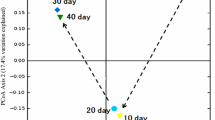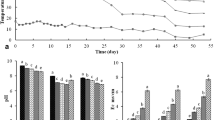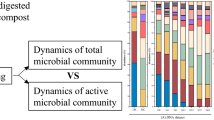Abstract
Empty fruit bunch (EFB) and palm oil mill effluent (POME) are the major wastes generated by the oil palm industry in Malaysia. The practice of EFB and POME digester sludge co-composting has shown positive results, both in mitigating otherwise environmentally damaging waste streams and producing a useful product (compost) from these streams. In this study, the bacterial ecosystems of 12-week-old EFB-POME co-compost and POME biogas sludge from Felda Maokil, Johor were analysed using 16S metagenome sequencing. Over ten phyla were detected, with Chloroflexi being the predominant phylum, representing approximately 53% of compost and 23% of the POME microbiome reads. The main bacterial lineage found in the compost and POME was Anaerolinaceae (Chloroflexi) with 30% and 18% of the total gene fragments, respectively. The significant differences between compost and POME communities were abundances of Syntrophobacter, Sulfuricurvum and Coprococcus. No methanogens were identified due to the bias in general 16S primers to eubacteria. The preponderance of anaerobic species in the compost and high abundance of secondary metabolite fermenting bacteria is due to an extended composting time, with anaerobic collapse of the pile due to the tropical heat. Predictive functional profiles of the metagenomes using 16S rRNA marker genes suggest that the presence of enzymes involved in degradation of polysaccharides such as glucoamylase, endoglucanase and arabinofuranosidase, all of which were strongly active in POME. Eubacterial species associated with cellulytic methanogenesis were present in both samples.







Similar content being viewed by others
References
Ahmad R, Jilani G, Arshad M, Zahir ZA, Khalid A (2007) Bio-conversion of organic wastes for their recycling in agriculture: an overview of perspectives and prospects. Ann Microbiol 57(4):471–479. https://doi.org/10.1007/bf03175343
Alessi AM, Bird SM, Bennett JP, Oates NC, Li Y, Dowle AA, Polikarpov I, Young JPW, McQueen-Mason SJ, Bruce NC (2017) Revealing the insoluble metasecretome of lignocellulose-degrading microbial communities. Sci Rep 7(1):2356. https://doi.org/10.1038/s41598-017-02506-5
Boone DR, Bryant MP (1980) Propionate-degrading bacterium, Syntrophobacter wolinii sp. nov. gen. nov., from methanogenic ecosystems. Appl Environ Microbiol 40(3):626–632
Brockett BFT, Prescott CE, Grayston SJ (2012) Soil moisture is the major factor influencing microbial community structure and enzyme activities across seven biogeoclimatic zones in western Canada. Soil Biol Biochem 44(1):9–20. https://doi.org/10.1016/j.soilbio.2011.09.003
Chan CS, Chan K-G, Tay Y-L, Chua Y-H, Goh KM (2015) Diversity of thermophiles in a Malaysian hot spring determined using 16S rRNA and shotgun metagenome sequencing. Front Microbiol 6:177. https://doi.org/10.3389/fmicb.2015.00177
Chandna P, Nain L, Singh S, Kuhad RC (2013) Assessment of bacterial diversity during composting of agricultural byproducts. BMC Microbiol 13(1):99. https://doi.org/10.1186/1471-2180-13-99
Chew YM, Lye S, Salleh M, Yahya A (2018) 16S rRNA metagenomic analysis of the symbiotic community structures of bacteria in foregut, midgut, and hindgut of the wood-feeding termite Bulbitermes sp. Symbiosis 76(2):187–197. https://doi.org/10.1007/s13199-018-0544-5
Costea PI, Zeller G, Sunagawa S, Pelletier E, Alberti A, Levenez F, Tramontano M, Driessen M, Hercog R, Jung F-E, Kultima JR, Hayward MR, Coelho LP, Allen-Vercoe E, Bertrand L, Blaut M, Brown JRM, Carton T, Cools-Portier S, Daigneault M, Derrien M, Druesne A, de Vos WM, Finlay BB, Flint HJ, Guarner F, Hattori M, Heilig H, Luna RA, van Hylckama Vlieg J, Junick J, Klymiuk I, Langella P, Le Chatelier E, Mai V, Manichanh C, Martin JC, Mery C, Morita H, O’Toole PW, Orvain C, Patil KR, Penders J, Persson S, Pons N, Popova M, Salonen A, Saulnier D, Scott KP, Singh B, Slezak K, Veiga P, Versalovic J, Zhao L, Zoetendal EG, Ehrlich SD, Dore J, Bork P (2017) Towards standards for human fecal sample processing in metagenomic studies. Nat Biotechnol 35:1069. https://doi.org/10.1038/nbt.3960 https://www.nature.com/articles/nbt.3960#supplementary-information. Accessed 2 Oct 2018
Escobar-Zepeda A, de León AV-P, Sanchez-Flores A (2015) The road to metagenomics: from microbiology to dna sequencing technologies and bioinformatics. Front Genet. https://doi.org/10.3389/fgene.2015.00348
Fernández-Arrojo L, Guazzaroni M-E, López-Cortés N, Beloqui A, Ferrer M (2010) Metagenomic era for biocatalyst identification. Curr Opin Biotechnol 21(6):725–733. https://doi.org/10.1016/j.copbio.2010.09.006
Fischer MA, Güllert S, Neulinger SC, Streit WR, Schmitz RA (2016) Evaluation of 16S rRNA gene primer pairs for monitoring microbial community structures showed high reproducibility within and low comparability between datasets generated with multiple archaeal and bacterial primer pairs. Front Microbiol 7:1297. https://doi.org/10.3389/fmicb.2016.01297
Griffiths RI, Whiteley AS, O’Donnell AG, Bailey MJ (2000) Rapid method for coextraction of DNA and RNA from natural environments for analysis of ribosomal DNA- and rRNA-based microbial community composition. Appl Environ Microbiol 66(12):5488–5491
Handelsman J (2004) Metagenomics: application of genomics to uncultured microorganisms. Microbiol Mol Biol Rev 68(4):669–685
Hatamoto M, Miyauchi T, Kindaichi T, Ozaki N, Ohashi A (2011) Dissolved methane oxidation and competition for oxygen in down-flow hanging sponge reactor for post-treatment of anaerobic wastewater treatment. Biores Technol 102(22):10299–10304. https://doi.org/10.1016/j.biortech.2011.08.099
Ito T, Sekizuka T, Kishi N, Yamashita A, Kuroda M (2018) Conventional culture methods with commercially available media unveil the presence of novel culturable bacteria. Gut Microbes. https://doi.org/10.1080/19490976.2018.1491265
Jia Y, Wilkins D, Lu H, Cai M, Lee PKH (2016) Long-term enrichment on cellulose or xylan causes functional and taxonomic convergence of microbial communities from anaerobic digesters. Appl Environ Microbiol 82(5):1519–1529. https://doi.org/10.1128/aem.03360-15
Kangle K, Kore S, Kore V, Kulkarni G (2012) Recent trends in anaerobic codigestion: a review. Univ J Environ Res Technol 2(4):210–219
Klindworth A, Pruesse E, Schweer T, Peplies J, Quast C, Horn M, Glöckner FO (2013) Evaluation of general 16S ribosomal RNA gene PCR primers for classical and next-generation sequencing-based diversity studies. Nucleic Acids Res 41(1):e1–e1. https://doi.org/10.1093/nar/gks808
Kodama Y, Watanabe K (2004) Sulfuricurvum kujiense gen. nov., sp. nov., a facultatively anaerobic, chemolithoautotrophic, sulfur-oxidizing bacterium isolated from an underground crude-oil storage cavity. Int J Syst Evol Microbiol 54(6):2297–2300. https://doi.org/10.1099/ijs.0.63243-0
Krishnan Y, Bong CPC, Azman NF, Zakaria Z, Othman NA, Abdullah N, Ho CS, Lee CT, Hansen SB, Hara H (2017) Co-composting of palm empty fruit bunch and palm oil mill effluent: microbial diversity and potential mitigation of greenhouse gas emission. J Clean Prod 146:94–100. https://doi.org/10.1016/j.jclepro.2016.08.118
Langille MGI, Zaneveld J, Caporaso JG, McDonald D, Knights D, Reyes JA, Clemente JC, Burkepile DE, Vega Thurber RL, Knight R, Beiko RG, Huttenhower C (2013) Predictive functional profiling of microbial communities using 16S rRNA marker gene sequences. Nat Biotechnol 31:814. https://doi.org/10.1038/nbt.2676 https://www.nature.com/articles/nbt.2676#supplementary-information. Accessed 17 Oct 2018
Liang B, Wang L-Y, Mbadinga SM, Liu J-F, Yang S-Z, Gu J-D, Mu B-Z (2015) Anaerolineaceae and Methanosaeta turned to be the dominant microorganisms in alkanes-dependent methanogenic culture after long-term of incubation. AMB Express 5(1):117. https://doi.org/10.1186/s13568-015-0117-4
Liu J, He X-x, Lin X-r, Chen W-c, Zhou Q-x, Shu W-s, Huang L-n (2015) Ecological effects of combined pollution associated with E-waste recycling on the composition and diversity of soil microbial communities. Environ Sci Technol 49(11):6438–6447. https://doi.org/10.1021/es5049804
Liu J, Chen X, Shu H-y, Lin X-r, Zhou Q-x, Bramryd T, Shu W-s, Huang L-n (2018) Microbial community structure and function in sediments from e-waste contaminated rivers at Guiyu area of China. Environ Pollut 235:171–179. https://doi.org/10.1016/j.envpol.2017.12.008
López-González JA, Suárez-Estrella F, Vargas-García MC, López MJ, Jurado MM, Moreno J (2015) Dynamics of bacterial microbiota during lignocellulosic waste composting: studies upon its structure, functionality and biodiversity. Biores Technol 175:406–416. https://doi.org/10.1016/j.biortech.2014.10.123
McDonald D, Price MN, Goodrich J, Nawrocki EP, DeSantis TZ, Probst A, Andersen GL, Knight R, Hugenholtz P (2012) An improved Greengenes taxonomy with explicit ranks for ecological and evolutionary analyses of bacteria and archaea. ISME J 6(3):610–618. https://doi.org/10.1038/ismej.2011.139
McIlroy SJ, Kirkegaard RH, Dueholm MS, Fernando E, Karst SM, Albertsen M, Nielsen PH (2017) Culture-independent analyses reveal novel anaerolineaceae as abundant primary fermenters in anaerobic digesters treating waste activated sludge. Front Microbiol. https://doi.org/10.3389/fmicb.2017.01134
Moore AM, Munck C, Sommer MOA, Dantas G (2011) Functional metagenomic investigations of the human intestinal microbiota. Front Microbiol 2:188. https://doi.org/10.3389/fmicb.2011.00188
MPOB (2017) Malaysian Oil palm industry performance 2016 and prospects for 2017. Malaysian Palm Oil Board (MPOB), Bandar Baru Bangi
Nalo T, Tasing K, Kumar S, Bharti A (2014) Anaerobic digestion of municipal solid waste: a critical analysis. Int J Innov Res Sci Eng Technol 3(4):2347–6710
Neher DA, Weicht TR, Bates ST, Leff JW, Fierer N (2013) Changes in bacterial and fungal communities across compost recipes, preparation methods, and composting times. PLoS One 8(11):e79512. https://doi.org/10.1371/journal.pone.0079512
Parks DH, Tyson GW, Hugenholtz P, Beiko RG (2014) STAMP: statistical analysis of taxonomic and functional profiles. Bioinformatics (Oxford, England) 30(21):3123–3124. https://doi.org/10.1093/bioinformatics/btu494
Raabe RD (1981) The rapid composting method. Cooperative extension. University of California, California
Ryckeboer J, Mergaert J, Vaes K, Klammer S, De Clercq D, Coosemans J, Insam H, Swings J (2003) A survey of bacteria and fungi occurring during composting and self-heating processes. Ann Microbiol 53:349–410
Schloss PD, Westcott SL, Ryabin T, Hall JR, Hartmann M, Hollister EB, Lesniewski RA, Oakley BB, Parks DH, Robinson CJ, Sahl JW, Stres B, Thallinger GG, Van Horn DJ, Weber CF (2009) Introducing mothur: open-source, platform-independent, community-supported software for describing and comparing microbial communities. Appl Environ Microbiol 75(23):7537–7541. https://doi.org/10.1128/AEM.01541-09
Sharpton TJ (2014) An introduction to the analysis of shotgun metagenomic data. Front Plant Sci. https://doi.org/10.3389/fpls.2014.00209
Siddiquee S, Shafawati SN, Naher L (2017) Effective composting of empty fruit bunches using potential Trichoderma strains. Biotechnol Rep 13:1–7. https://doi.org/10.1016/j.btre.2016.11.001
Sulaiman F, Abdullah N, Gerhauser H, Shariff A (2011) An outlook of Malaysian energy, oil palm industry and its utilization of wastes as useful resources. Biomass Bioenerg 35(9):3775–3786
Sun L, Toyonaga M, Ohashi A, Matsuura N, Tourlousse DM, Meng X-Y, Tamaki H, Hanada S, Cruz R, Yamaguchi T, Sekiguchi Y (2016) Isolation and characterization of Flexilinea flocculi gen. nov., sp. nov., a filamentous, anaerobic bacterium belonging to the class Anaerolineae in the phylum Chloroflexi. Int J Syst Evol Microbiol 66(2):988–996. https://doi.org/10.1099/ijsem.0.000822
Sutton NB, Maphosa F, Morillo JA, Abu Al-Soud W, Langenhoff AAM, Grotenhuis T, Rijnaarts HHM, Smidt H (2013) Impact of long-term diesel contamination on soil microbial community structure. Appl Environ Microbiol 79(2):619–630. https://doi.org/10.1128/AEM.02747-12
Toledo M, Gutiérrez MC, Siles JA, García-Olmo J, Martín MA (2017) Chemometric analysis and NIR spectroscopy to evaluate odorous impact during the composting of different raw materials. J Clean Prod 167:154–162. https://doi.org/10.1016/j.jclepro.2017.08.163
Verma D, Satyanarayana T (2011) An improved protocol for DNA extraction from alkaline soil and sediment samples for constructing metagenomic libraries. Appl Biochem Biotechnol 165(2):454. https://doi.org/10.1007/s12010-011-9264-5
Vishan I, Sivaprakasam S, Kalamdhad A (2017) Isolation and identification of bacteria from rotary drum compost of water hyacinth. Int J Recycl Org Waste Agric 6(3):245–253. https://doi.org/10.1007/s40093-017-0172-8
Wang C, Dong D, Wang H, Müller K, Qin Y, Wang H, Wu W (2016) Metagenomic analysis of microbial consortia enriched from compost: new insights into the role of Actinobacteria in lignocellulose decomposition. Biotechnol Biofuels 9:22. https://doi.org/10.1186/s13068-016-0440-2
Wei H, Wang L, Hassan M, Xie B (2018) Succession of the functional microbial communities and the metabolic functions in maize straw composting process. Biores Technol 256:333–341. https://doi.org/10.1016/j.biortech.2018.02.050
Wu J, Zhao Y, Qi H, Zhao X, Yang T, Du Y, Zhang H, Wei Z (2017) Identifying the key factors that affect the formation of humic substance during different materials composting. Biores Technol 244:1193–1196. https://doi.org/10.1016/j.biortech.2017.08.100
Yamada T, Sekiguchi Y, Hanada S, Imachi H, Ohashi A, Harada H, Kamagata Y (2006) Anaerolinea thermolimosa sp. nov., Levilinea saccharolytica gen. nov., sp. nov. and Leptolinea tardivitalis gen. nov., sp. nov., novel filamentous anaerobes, and description of the new classes Anaerolineae classis nov. and Caldilineae classis nov. in the bacterial phylum Chloroflexi. Int J Syst Evol Microbiol 56(6):1331–1340. https://doi.org/10.1099/ijs.0.64169-0
Yan X, Luo X, Zhao M (2016) Metagenomic analysis of microbial community in uranium-contaminated soil. Appl Microbiol Biotechnol 100(1):299–310. https://doi.org/10.1007/s00253-015-7003-5
Acknowledgements
The authors would like to thank Jamal Al Deen Lawton for compost advice. We greatfully acknowledge oil palm mill Felda Maokil, Labis, Johor for providing us with compost and POME samples. This work was financially supported Ministry of Education Malaysia and Biotechnology and Biological Sciences Research Council (BBSRC) United Kingdom under program of United Kingdom-Southeast Asia Newton Ungku Omar Fund (UK-SEA-NUOF) with project number 4B297 and BB/P027717/1.
Author information
Authors and Affiliations
Corresponding authors
Ethics declarations
Conflict of interest
On behalf of all the authors, the corresponding author states that there is no conflict of interest.
Rights and permissions
About this article
Cite this article
Khalid, N.A., Rajandas, H., Parimannan, S. et al. Insights into microbial community structure and diversity in oil palm waste compost. 3 Biotech 9, 364 (2019). https://doi.org/10.1007/s13205-019-1892-4
Received:
Accepted:
Published:
DOI: https://doi.org/10.1007/s13205-019-1892-4




